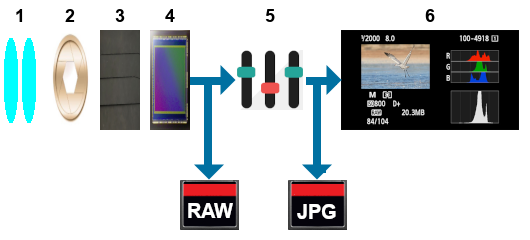Tutorial - How a reflex (SLR) camera works?
(Javascript must be enabled on your browser)

SLR cameras (Single Lens Reflex) are all made in the same way. Their main feature is that they allow the view through the lens. In other words, when the photographer frames his photo, he sees the image exactly as it will appear on the sensor, with no parallax error, and taking into account all the accessories fitted to the lens at that moment: filters in particular.
This construction also means that the lens can be changed while the viewfinder remains identical to the final photo. These advantages imply a fairly significant complication in the mechanism: the light has to be diverted towards the viewfinder while the photographer is framing the image, and direct it towards the sensor when the photo is taken.
This switching of light is the role of the mirror. At rest, it directs light towards the viewfinder. When the shutter release is pressed, it rises to let the light reach the sensor or the film.

Internal mechanism of a reflex camera
- The lens and its lenses.
Also known as "optics", this component plays an essential role. Its quality has a direct influence on the quality of your photos. - The diaphragm.
It is made up of hinged blades that allow the size of the aperture to be adjusted while maintaining as circular a shape as possible. The diaphragm is used to control the amount of light entering the lens.



F/4 Aperture F/8 Aperture F/16 Aperture - The mirror.
During fraiming, it reflects light back to the prism and from there to the viewfinder. It rises when the shutter release is pressed to let the light reach the sensor behind it. - The shutter.
The shutter opens for a specific time to let the light reach the sensor. The shutter and diaphragm determine the amount of light that reaches the sensor or the film. These two accessories therefore act together on exposure. - The sensor or the film.
Whether it's the sensor on a digital camera or the film on a film camera, the role is the same: to capture the image. - The prism.
A block of glass that reflects light back towards the viewfinder. The prism is only useful during framing. - The viewfinder.
You apply your eye to it to "see" the future photo and fine-tune the framing. This is known as an optical viewfinder. In contrast, the screens on the back of the camera are digital viewfinders. These can also be used to frame the photo, and have improved considerably since the arrival of hybrid cameras. But eyepiece viewfinders still have a few advantages:- The position of the arms imposed by the optical viewfinder gives greater stability.
- The optical viewfinder emits no light. When discretion is required, this is a definite advantage.
What happens when you press the shutter release ?
When you press the shutter release button, the shot seems almost instantaneous. However, your SLR camera performs a number of operations.
- Focus adjustment (1).
- Calculation of exposure parameters (2).
- Closing the diaphragm according to the value calculated above (3).
- Raising the mirror. The light is no longer directed towards the viewfinder but towards the sensor.
- Shutter opening.
- Flash release (if required).
- The shutter closes after the exposure time determined above.
- Lowering the mirror.
- Memory card recording (4).
(1) Adjusting the focus is a mechanical operation that involves moving lenses or groups of lenses inside the lens. In other words, it's a fairly lengthy operation.
(2) A measuring cell built into the camera measures the light. The internal programme then calculates the shooting parameters, essentially the exposure time (shutter speed) and aperture based on the light intensity measured by the cell.
(3) At rest, the diaphragm is always open to the maximum so that the viewfinder is as clear as possible.
(4) If the recording is in JPG format, there is also a conversion and image processing phase.
This sequence of operations may differ depending on the camera settings: automatic mode or manual mode, flash triggering on the second curtain, continuous focus, mirror up option, etc.
Where the settings are made in an SLR camera ?
The diagram below shows the main components of an SLR camera, in their respective positions in relation to each other. The lenses (1) and diaphragm (2) are located in the lens. Everything else is in the camera body. In order to clarify the diagram, components that are not involved in adjustment, such as the mirror, have not been shown.

(1) The lenses ensure focus by moving more or less inside the lens. Whether focus is achieved manually or automatically makes no difference to the fact that the lenses have to move to adjust the focus on the subject.
(2) The diaphragm is used to adjust the aperture, which is one of the three exposure parameters.
(3) The shutter also affects exposure by adjusting the exposure time.
(4) The sensor itself, which is used to modify the sensitivity (in ISO).
This is the third parameter that affects the exposure of the photo.
The data from the sensor is recorded as it in the RAW file. Additional data is also recorded,
essentially to keep track of the parameters chosen for the photo. This information is called "metadata" or EXIF.
But it is essential to remember that the image data comes directly from the sensor, without any special processing.
(5) Adjustments made by the camera itself: choice of colour space, white balance, colour saturation adjustment, etc. These adjustments are used to produce an image in JPG format. Even if you don't need to save the image to the card, it is created for display on the back of the camera.
(6) The screen on the back of the camera. It displays the photo that has just been taken and lots of other information including the histogram. It is also possible to view the shooting parameters. It should be noted that the histogram is produced from the JPG image, and therefore includes all the settings made by the camera: it is not the histogram of the RAW image.
What can we deduce from this ?
We can see that two settings act before the sensor: focus and exposure. These are purely optical settings, which modify the light before it reaches the sensor. A change in these settings will cause a change in the data supplied by the sensor and recorded in the RAW file. This is not the case with the other settings (such as white balance), which act when the JPG image is created.
Consequently, the two settings that need to be right from the moment you take the shot are focus and exposure. Today's post-processing software can sometimes work miracles, but correcting a focus that has not been set on the subject is still an acrobatic feat. The same is true of poor exposure, which may have burnt out (overexposed) or blocked out (underexposed) some areas of the photo. The missing data cannot be recovered because it has not been recorded by the sensor.
On the other hand, purely electronic settings such as white balance, colour saturation, etc. can be modified in post-processing without any problem.
You can also see that the image displayed on the back of the camera, and the corresponding histogram, take into account all the settings used to create the JPG (white balance, colour saturation, etc.). Contrary to what many photographers think, the histogram is not an accurate tool for assessing photo exposure. You can easily convince yourself of this by doing the following test: take two photos of the same subject, changing only the white balance between the two shots. You'll see that the two histograms are different. One of them may even indicate over or underexposure. This is not the reality, as both photos have been exposed in the same way.
Another way of putting it is that the histogram on the back of the camera is that of a JPG developed by the camera itself. But the photographer may well opt for a different development, which will have an effect on the apparent exposure of the photo.
Note: when you open a RAW file in a program such as Lightroom, you get the impression that all the settings you made when you took the shot are taken into account. For example, the white balance is applied as chosen on the camera. This gives the impression that these settings have had an impact on the RAW data, but this is not the case: the RAW data is not modified by the white balance, but the software applies the settings it finds in the EXIF metadata as soon as the file is opened.
The future of reflex cameras.
The very principle of the SLR implies complex and therefore expensive mechanisms. Several manufacturers are looking for alternative solutions that would allow simpler manufacturing. One example is Sony's semi-transparent mirrors.
More recently, hybrid cameras have emerged as serious competitors to SLRs: hybrids are just as powerful and have fewer mechanical parts. and have fewer mechanical parts. So they weigh less, take up less space and cost less.


If you liked this page, share it on your favorite network :